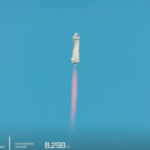NASA Perseverance rover successfully launched aboard a United Launch Alliance Atlas V rocket from Space Launch Complex 41 at Cape Canaveral Air Force Station in Florida. The car-sized rover is officially on its way to its landing site, Jezero Crater on Mars, where it is set to arrive in about seven months on Feb. 18, 2021.
The main job of the Perseverance rover is to seek signs of ancient life and collect rock and soil samples for possible return to Earth according to NASA.
The mission named Mars 2020, which was scheduled within a launch period of approximately three weeks, from July 30 to August 15, was successfully launched on Thursday.
The Mars 2020/Perseverance rover is designed to better understand the geology of Mars and seek signs of ancient life. The mission will collect and store a set of rock and soil samples that could be returned to Earth in the future.
Read also; Zimbabwe to compensate White Farmers with $3.5 billion in a new deal
Bobby Braun, director of planetary science at NASA’s Jet Propulsion Laboratory. said that “to be on our way, after all this work that the team has gone through— it’s really just fantastic.”
Key Objectives of Mars 2020 mission
- Explore a geologically diverse landing site
- Assess ancient habitability
- Seek signs of ancient life, particularly in special rocks known to preserve signs of life over time
- Gather rock and soil samples that could be returned to Earth by a future NASA mission
- Demonstrate technology for future robotic and human exploration
🚀 We have LIFTOFF to Mars! The @ulalaunch Atlas V takes flight with our @NASAPersevere rover. The #CountdownToMars continues as Perseverance begins her 7-month journey to the Red Planet! pic.twitter.com/3RTL1CR4WS
— NASA (@NASA) July 30, 2020
Written by;
Ifunanya Ikueze






















































